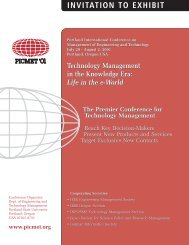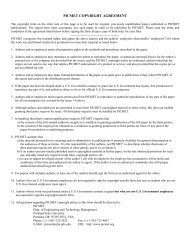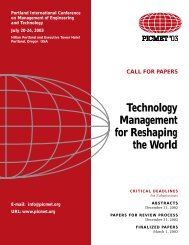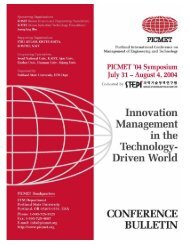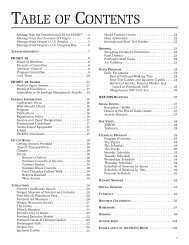Technology & Innovation Management: - PICMET Conference
Technology & Innovation Management: - PICMET Conference
Technology & Innovation Management: - PICMET Conference
You also want an ePaper? Increase the reach of your titles
YUMPU automatically turns print PDFs into web optimized ePapers that Google loves.
PAPERS AND PANELS<br />
jects is to reduce this risk. This paper examines project risk management<br />
in new product development, focusing on technical risk and<br />
identifying a number of relevant heuristics from the fields of product<br />
and systems development.<br />
TB-01.2 - Knowledge Transfer in New Product Development<br />
Charles O’Mara, University of Western Sydney<br />
Paul W.B. Hyland, University of Western Sydney<br />
Terry Sloan, University of Western Sydney<br />
Capturing the lessons learned in product innovation projects is one<br />
way to apply the principles of continuous improvement to innovation<br />
management. In this paper we report on research carried out<br />
with an Australian aerospace firm and examine how the lessons<br />
learn in developing new products are transferred to subsequent as<br />
well as exisiting projects.<br />
TB-01.3 - Operational Agility in Taiwan’s Microelectronics and<br />
Information Industry<br />
Yee-Yeen Chu, National Tsing-Hua University<br />
Wen-How Pyi, National Tsing Hua University<br />
This paper presents a study directed to the investigation of the agility<br />
of Taiwan’s microelectronics and information industry. The paper<br />
addresses the business practices and indicators that reflect the rapid<br />
development and manufacturing capabilities as well as flexible management<br />
structures that support an agile organization in response to<br />
the rapidly changing environment.<br />
TB-02 Tuesday, July 27, 1999<br />
10:00 - 11:30 Galleria-2<br />
R&D <strong>Management</strong> -3: R&D Portfolio <strong>Management</strong><br />
Chair: Michael M Menke, Value Creation Associates<br />
TB-02.1 - The Diverse Personalities of Portfolio <strong>Management</strong>:<br />
Variations on a Theme<br />
Michael Menke, Value Creation Associates<br />
Portfolio management has become an important R&D management<br />
approach to ensure that R&D resources are deployed in support of<br />
business strategy and to maximize the return on the R&D investment.<br />
However different organizations, both users and consultants, have<br />
very different portfolio management approaches. This paper identifies<br />
the key features and distinctions of three fundamental approaches<br />
that we call cost-based, time-based and value-based. Although<br />
these approaches individually use quite different methodologies and<br />
metrics, it is possible and desirable to integrate them into one comprehensive<br />
R&D strategic management process.<br />
TB-02.2 - Decision Analysis in Early Pharmaceutical Development<br />
Les Bell, Searle Research and Development<br />
Pharmaceutical research is characterized by high risks and long time<br />
horizons, yet the rewards for making the right decisions can be substantial.<br />
At Monsanto we have created a flexible decision analysis<br />
process that allows us to examine individual project strategies and to<br />
understand portfolio optimization issues.<br />
TB-02.3 - Assessing the Validity of a Group Decision Support System<br />
Martin Read, University of Portsmouth<br />
Tony Gear, Universtiy of Glamorgan<br />
The paper describes a case study concerning the use of a Group<br />
Decision Support System (GDSS) to help senior research and development<br />
managers in the pharmaceutical industry determine a<br />
Development Portfolio, and addresses issues concerned with the<br />
validity of the use of the GDSS in this context.<br />
TB-02.4 - Prototype-Based Life Cycle Costing in R&D<br />
Markus Pfohl, Universitaet Stuttgart<br />
In R&D 75 to 85 percent of accumulated product life cycle costs are<br />
determined, even though only five to seven percent of these costs are<br />
inccured to this time. This gap between cost detemination and cost<br />
accumulated, and the fact that the development and marketing of<br />
new products is related to increasing investments, requires a lifecycle<br />
oriented perspective in the R&D: life-cycle cost and life-cycle<br />
profitability of an object have to be analysed. Recent developments<br />
in technologies of Rapid Prototyping allow one to use more realistic<br />
prototypes in the early stages of R&D. The prototypes could be used<br />
as a means of communication. They help to explicate the implicit<br />
knowledge which process the representatives of the different functions,<br />
like R&D, marketing, logistics, etc., of the producers, the suppliers<br />
and the customers. So the prototypes are an excellent instrument<br />
to support the product life cycle cost and profitability analysis.<br />
TB-03 Tuesday, July 27, 1999<br />
10:00 - 11:30 Galleria-3<br />
<strong>Management</strong> of Technological <strong>Innovation</strong> - 4<br />
Chair: Jeff Butler, Manchester Business School<br />
TB-03.1 - Global <strong>Innovation</strong> Teams: A Requirement for the New<br />
Millennium<br />
Kathleen Wheatley, Syracuse University<br />
David Wilemon, Syracuse University<br />
Global teamwork is becoming a requirement at all levels of the firm<br />
from strategy to product development. This new requirement creates<br />
many issues that need addressing in order to capture the potential<br />
synergies associated with global teams. Some actions/guidelines are<br />
presented here that can assist global team leaders as they manage<br />
their teams in the next millennium.<br />
TB-03.2 - A Practical Model for <strong>Technology</strong> and <strong>Innovation</strong><br />
<strong>Management</strong><br />
Jeff Butler, Manchester Business School<br />
Javier Ruiz, Manchester Business School<br />
A three-part model is used in a European guide to technology and<br />
innovation management. The model describes technology management<br />
practices and the innovation process and introduces practical<br />
tools and techniques. It facilitates strategic development, operational<br />
efficiency and a learning philosophy, and integrates these into an<br />
overall business performance for SMEs and large companies.<br />
<strong>Innovation</strong> and technology management can be audited to improve<br />
business performance.<br />
TB-03.3 - Public Research and Industrial <strong>Innovation</strong>s<br />
Marian Beise, University of Karlsruhe<br />
This paper deals with the short-term effects of publicly funded<br />
research at universities, polytechnics and federal research labs on<br />
industrial innovations in Germany. In questioning 2,300 companies<br />
we found that less than one tenth of innovating firms have<br />
introduced innovations between 1993 and 1995 that would not<br />
have been developed without public research. We discuss the<br />
characteristics of these companies that benefit from the findings of<br />
public research institutions and the most supportive research<br />
institutes.<br />
TB-04 Tuesday, July 27, 1999<br />
10:00 - 11:30 Parlor B<br />
<strong>Technology</strong> Transfer - 1<br />
Chair: Kiyoshi Niwa, University of Tokyo<br />
49



